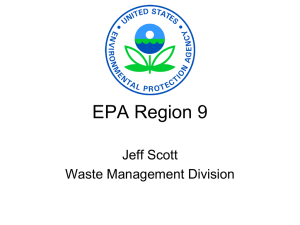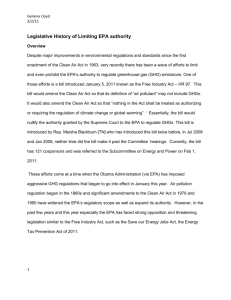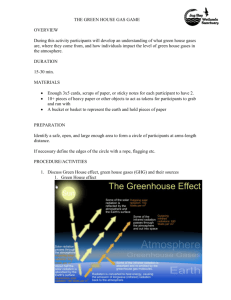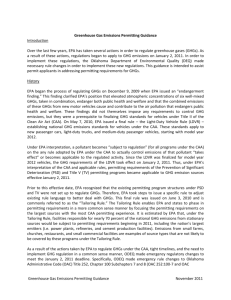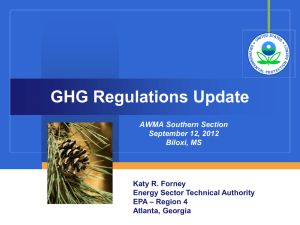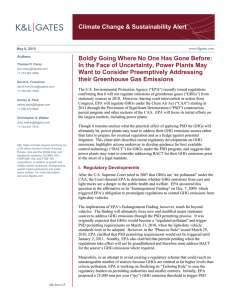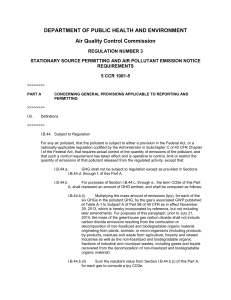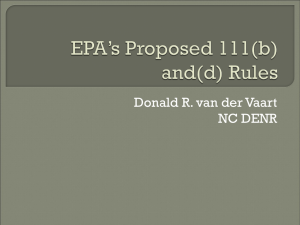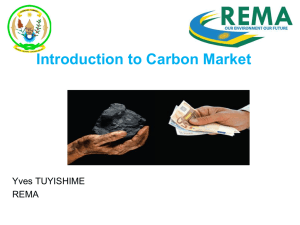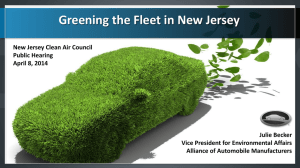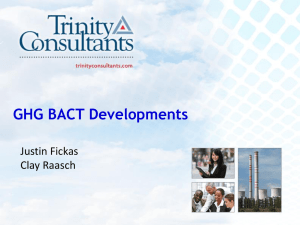ADEQ Greenhouse Gases Presentation
advertisement
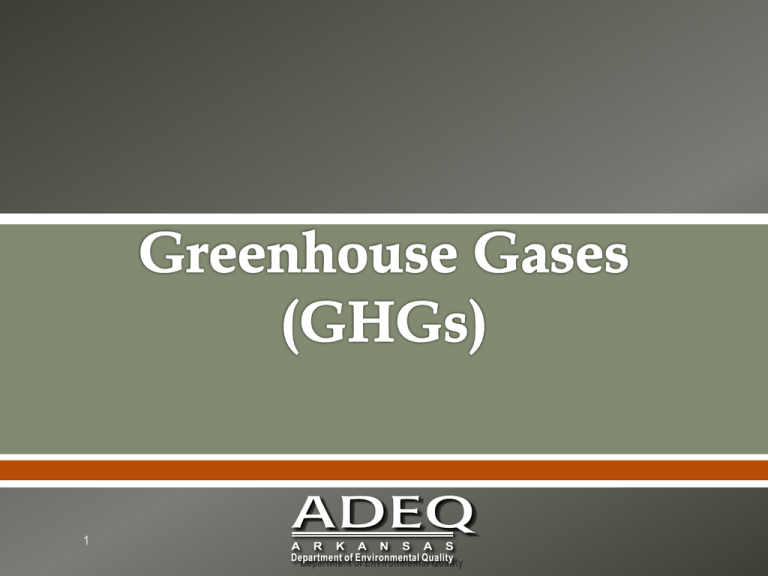
1 • Carbon dioxide (CO2) – Naturally occurring and manmade. 5,505.2 mmts emitted in 2009, GWP = 1 • Methane (CH4) - Naturally occurring and man-made. 686.3 mmts emitted in 2009, GWP = 21 • Nitrous Oxide (N2O) - Naturally occurring and man-made. 295.6 mmt emitted in 2009, GWP = 310 • Hydrochlorofluorocarbons (HCFCs) - Man-made. 125.7 mmt emitted in 2009, GWP = 140 – 11,700 • Sulphur Hexafloride (SF6) – Man-made. 14.8 mmts emitted in 2009, GWP = 23,900 • Perfluorocarbons (PFCs) - Man-made. 5.6 mmts emitted in 2009, GWP = 6,500 – 9,200 2 Certainties • We do know that the earth’s atmosphere is getting warmer. • We do know that man contributes to the release of GHGs. 3 Uncertainties • It is disputed whether curbing man’s contribution could reverse the warming trend. And then, how much reduction is necessary to see a change in temperature. • It is disputed whether the U.S. should move forward if other major GHG emitting countries are not, i.e. can we really accomplish anything globally by ourselves. • It is disputed whether the existing Clean Air Act is the best way to regulate GHGs. 4 • Massachusetts v. EPA: April 2, 2007, the U.S. Supreme Court found that greenhouse gases (GHGs), including carbon dioxide, fit within the definition of air pollutant under the Clean Air Act (CAA). • EPA signed the Endangerment Finding and the Cause or Contribute Finding. Both are under legal challenge. • Thus the road is paved to regulate GHGs under the CAA Standards for light-duty vehicles came first; triggering regulation under all portions of the Clean Air Act by January 2, 2011. This rule is also under legal challenge. 5 • No ground-level NAAQS to use for permit review and compliance. • CO2 is a very common pollutant at the normal CAA permitting thresholds. • BACT is problematic as there are no or limited commercially available technologies to treat or sequester GHGs (varies by GHG). • However, Congress was unable to reach consensus on an alternative plan such as “cap and trade” or a national reduction standard. 6 Case–by–Case analysis in which the Permitting Authority must: • Identify all available control technologies • Eliminate technically infeasible options • Rank remaining control technologies • Evaluate most effective controls and document results • Select BACT 7 • Promulgated June 3, 2010 • Raises the thresholds for GHG emissions that require permits under the PSD and Title V Operating Permit programs. • Defines when PSD/Title V permits are required for new and existing industrial facilities. • EPA to consider regulating sources of lower emission rates and other permit streamlining measures (Final rule due July 1, 2012). 8 • Electric Generating Units: o Approximately 11 affected facilities. • General Industry (based on 2008 stationary fuel combustion): o Approximately 14 affected facilities. • Landfills: o Approximately 12 affected facilities. *Without emissions monitoring data there is a large amount of uncertainty in facility numbers and implementation of the reporting rule was delayed* 9 September 2, 2010, EPA published the proposed rule: Action to Ensure Authority to Issue Permits under the Prevention of Significant Deterioration Program to Sources of Greenhouse Gas Emissions: Finding of Substantial Inadequacy and SIP Call. 10 • Arkansas was one of 13 states subject to this “SIP Call,” which requires those states whose programs do not currently cover GHG emissions to revise their SIPs to ensure that their PSD programs cover GHG emissions consistent with EPA. • There was no way Arkansas could meet the January 2, 2011 deadline. 11 • ADEQ decided that it was in the best interest of the state to allow the FIP to take effect so that permitting and projects could move forward while we worked on changes to our regulations and SIP. 12 • We have a working agreement with EPA that we will review and draft the GHG portion of any PSD permit and EPA will issue that portion through their administrative processes. • We are working on changes to our regulations. Public comment period is over, and we are working on a comment response document and any needed changes to draft rules. 13 • We are watching permitting actions across the country to understand how the BACT analysis is working and what the GHG conditions look like. Energy efficiency… • We have the first PSD permit in house that potentially trips GHG review. • Waiting on EPA guidance regarding Title V GHG permitting until State Program Approvals are granted. 14 Questions? 15
